Archive for the ‘Scientific’ Category
Wednesday, January 6th, 2010
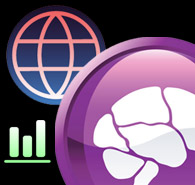 To someone who has been educated in the sciences it is somewhat jarring to see so many people blithely dismiss the alarming evidence in favor of global warming. And yet when it comes to neurofeedback, we are quite comfortable flying in the face of mainstream thinking and simply dismissing the mainstream position (of skepticism with respect to neurofeedback) as essentially meaningless. In one case, we regard scientific consensus as highly significant; in the other, we hold it in utter contempt. How can one justify both positions simultaneously? To someone who has been educated in the sciences it is somewhat jarring to see so many people blithely dismiss the alarming evidence in favor of global warming. And yet when it comes to neurofeedback, we are quite comfortable flying in the face of mainstream thinking and simply dismissing the mainstream position (of skepticism with respect to neurofeedback) as essentially meaningless. In one case, we regard scientific consensus as highly significant; in the other, we hold it in utter contempt. How can one justify both positions simultaneously?
The answer lies in the nature of the evidence for both propositions. What makes the case in favor of global warming so persuasive is that it is supported by so many independent lines of evidence, all of which collectively support a model that in turn is also well-supported, namely the key influence of atmospheric CO2 concentrations on global temperatures. Much of this evidence came to exist in the course of research that was unrelated to the issue of global warming. Add to the known influence of CO2 that of many other gaseous effluents, which can be tens to thousands of times worse in terms of their greenhouse effect, and we have ourselves a rather dangerous stew.
For evidence, one needs to look at those changes that average over short-term fluctuations, and one needs to look at regions where the effects are expected to be largest and to show up first: the arctic. Already we know that arctic summer sea ice is running at less than half of what it was half a century ago. Ominous signs of the decay of ice sheets are also seen in the Antarctic. Supporting evidence is then furnished by such findings as arctic flowers blooming earlier, butterflies moving their territories northward in England, and birds advancing the calendar on their nesting behavior. Altered composition of phytoplankton in arctic waters indicates that chemical changes have reached the level of biological significance.
(more…)
Posted in Commentary, Neurofeedback, Professional Issues, Research, Scientific | 2 Comments »
Wednesday, September 2nd, 2009
 Thus reads the title of an editorial in Science Magazine by Cornell physicist Kurt Gottfried and former head of the NIH Harold Varmus in the March 20 issue. On behalf of the larger scientific community that is breathing a collective sigh of relief, the authors want to acknowledge the new regime in Washington. Said President Obama: “promoting science isn’t just about providing resources—it is also about protecting free and open inquiry…free from manipulation or coercion, and listening to what [scientists] tell us, even when it is inconvenient—especially when it is inconvenient.” Thus reads the title of an editorial in Science Magazine by Cornell physicist Kurt Gottfried and former head of the NIH Harold Varmus in the March 20 issue. On behalf of the larger scientific community that is breathing a collective sigh of relief, the authors want to acknowledge the new regime in Washington. Said President Obama: “promoting science isn’t just about providing resources—it is also about protecting free and open inquiry…free from manipulation or coercion, and listening to what [scientists] tell us, even when it is inconvenient—especially when it is inconvenient.”
In the President’s Memorandum of Scientific Integrity he called for new standards “designed to guarantee scientific integrity throughout the executive branch” and to ensure “that scientific data are never distorted or concealed to serve a political agenda.” This is as it should be. It takes care of the “in-house” problem that we had within the Executive branch during the previous Administration, where manipulation and coercion were rampant.
Site map
(more…)
Posted in Research, Scientific | 5 Comments »
Thursday, August 6th, 2009
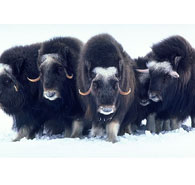 It goes without saying that mainstream thinking about neurofeedback to date has been mistaken. The original attempts at replication of Kamiya’s work on alpha training for anxiety were misguided in their methodology and in their conclusions. The rejection of Sterman’s and Lubar’s collective body of work was a blunder of the first magnitude. The continued dismissal of the claims of neurofeedback in the face of mounting evidence is indefensible. On the other hand, nothing here really surprises. A paradigm shift of such magnitude will be resisted by the mainstream on all fours. Everything has gone true to the historical pattern with respect to scientific revolutions. It goes without saying that mainstream thinking about neurofeedback to date has been mistaken. The original attempts at replication of Kamiya’s work on alpha training for anxiety were misguided in their methodology and in their conclusions. The rejection of Sterman’s and Lubar’s collective body of work was a blunder of the first magnitude. The continued dismissal of the claims of neurofeedback in the face of mounting evidence is indefensible. On the other hand, nothing here really surprises. A paradigm shift of such magnitude will be resisted by the mainstream on all fours. Everything has gone true to the historical pattern with respect to scientific revolutions.
(more…)
Posted in ADD / ADHD, Application of Neurofeedback, Neurofeedback, Research, Scientific | 11 Comments »
Thursday, August 6th, 2009
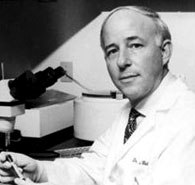 The recent death of Joel Weisman, MD, presents another occasion to reflect upon the process of scientific research at its very early stages, where the usual rules by which knowledge is enshrined are not yet in place. Weisman was a general practitioner in our home town of Sherman Oaks in 1980 when he noticed three patients with a common set of symptoms—fevers, rashes, weight loss, and swollen lymph nodes. An immune deficiency was indicated, so Weisman referred his patients to immunologist Martin Gottlieb at UCLA, who at that moment was treating a patient with the same set of symptoms. All were gay men. Said Gottlieb of Weisman: “In his practice he was alert to unusual symptoms in his patients. He had a sense that something out of the ordinary was happening.” This was, of course, the beginning of the discovery of AIDS. Weisman was never a scientist, but he could serve the process of scientific advance simply through good observation of those who in his own seasoned clinical judgment were outliers. He was in a much better position to do that than most closeted researchers doing formal studies. These fortuitous discoveries are an essential part of the scientific process. But because such anecdotal observations do not by themselves rise to the level of scientifically valid evidence, they are often disparaged, particularly when the data do not fit the prevailing paradigm. As a result, mature scientific disciplines eventually acquire some of the characteristics of a mature religion. They protect themselves against heresy just as religions do. This is no knock on religion. That’s where heresy can be well-defined with respect to established tenets of belief, and that’s where it belongs. The scientific process is supposed to be more open. Heresy should have no place there. The recent death of Joel Weisman, MD, presents another occasion to reflect upon the process of scientific research at its very early stages, where the usual rules by which knowledge is enshrined are not yet in place. Weisman was a general practitioner in our home town of Sherman Oaks in 1980 when he noticed three patients with a common set of symptoms—fevers, rashes, weight loss, and swollen lymph nodes. An immune deficiency was indicated, so Weisman referred his patients to immunologist Martin Gottlieb at UCLA, who at that moment was treating a patient with the same set of symptoms. All were gay men. Said Gottlieb of Weisman: “In his practice he was alert to unusual symptoms in his patients. He had a sense that something out of the ordinary was happening.” This was, of course, the beginning of the discovery of AIDS. Weisman was never a scientist, but he could serve the process of scientific advance simply through good observation of those who in his own seasoned clinical judgment were outliers. He was in a much better position to do that than most closeted researchers doing formal studies. These fortuitous discoveries are an essential part of the scientific process. But because such anecdotal observations do not by themselves rise to the level of scientifically valid evidence, they are often disparaged, particularly when the data do not fit the prevailing paradigm. As a result, mature scientific disciplines eventually acquire some of the characteristics of a mature religion. They protect themselves against heresy just as religions do. This is no knock on religion. That’s where heresy can be well-defined with respect to established tenets of belief, and that’s where it belongs. The scientific process is supposed to be more open. Heresy should have no place there.
(more…)
Posted in Commentary, Research, Scientific | 2 Comments »
Thursday, July 16th, 2009
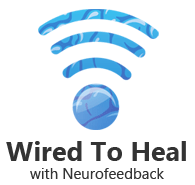 Dr. Siegfried Othmer the Chief Scientist for the EEG Institute goes onlinewithandrea to discuss Neurofeedback and how it is used to help conditions such as Anxiety, Autism, Cerebral Palsy, Depression, Seizures, Post Traumatic Syndrome, ADD/ADHD, Sleep Disorders, and many others. Dr. Siegfried Othmer the Chief Scientist for the EEG Institute goes onlinewithandrea to discuss Neurofeedback and how it is used to help conditions such as Anxiety, Autism, Cerebral Palsy, Depression, Seizures, Post Traumatic Syndrome, ADD/ADHD, Sleep Disorders, and many others.
Hosted by Andrea R. Garrison
This interview is approximately 2.5 hours in length.
To listen to this interview:
Click on the image of the multimedia player below to be taken to the blogtalkradio.com website.

Posted in ADD / ADHD, Application of Neurofeedback, Clinical Methods, Commentary, Efficacy, Neurofeedback, Scientific | No Comments »
Wednesday, May 21st, 2008
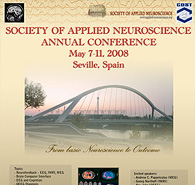
It is said that an emerging democracy should be judged not by its first election, but rather by its second. Perhaps similarly a new organization should be judged not by its first conference but by its second. The Society of Applied Neuroscience just held its second biannual conference in Seville, Spain, and by the above standard seems to be well on its way. The SAN spun off from the ISNR after the Winterthur conference in February of 2004. It held its first conference in Swansea in 2006. On the order of 200 people came to this one.
One motivation for the organizational separation was the feeling among some European academics that the ISNR was not sufficiently scientifically rigorous. One could also read that to mean it was not dominated by academics. In response, the conference program certainly reflected a high level of meaty scientific content. But when it came to the neurofeedback presentations by the academics, the disconnect from the clinical world was only too apparent. (more…)
Posted in Conferences, Research, Scientific | No Comments »
|
|
Subscribe to Email Newsletter
The EEG Info Newsletter circulates via email at least once a month. A variety of topics related to the Neurofeedback / EEG Biofeedback field are covered in over 200 articles.
|
 Thus reads the title of an editorial in Science Magazine by Cornell physicist Kurt Gottfried and former head of the NIH Harold Varmus in the March 20 issue. On behalf of the larger scientific community that is breathing a collective sigh of relief, the authors want to acknowledge the new regime in Washington. Said President Obama: “promoting science isn’t just about providing resources—it is also about protecting free and open inquiry…free from manipulation or coercion, and listening to what [scientists] tell us, even when it is inconvenient—especially when it is inconvenient.”
Thus reads the title of an editorial in Science Magazine by Cornell physicist Kurt Gottfried and former head of the NIH Harold Varmus in the March 20 issue. On behalf of the larger scientific community that is breathing a collective sigh of relief, the authors want to acknowledge the new regime in Washington. Said President Obama: “promoting science isn’t just about providing resources—it is also about protecting free and open inquiry…free from manipulation or coercion, and listening to what [scientists] tell us, even when it is inconvenient—especially when it is inconvenient.”
 It goes without saying that mainstream thinking about neurofeedback to date has been mistaken. The original attempts at replication of Kamiya’s work on alpha training for anxiety were misguided in their methodology and in their conclusions. The rejection of Sterman’s and Lubar’s collective body of work was a blunder of the first magnitude. The continued dismissal of the claims of neurofeedback in the face of mounting evidence is indefensible. On the other hand, nothing here really surprises. A paradigm shift of such magnitude will be resisted by the mainstream on all fours. Everything has gone true to the historical pattern with respect to scientific revolutions.
It goes without saying that mainstream thinking about neurofeedback to date has been mistaken. The original attempts at replication of Kamiya’s work on alpha training for anxiety were misguided in their methodology and in their conclusions. The rejection of Sterman’s and Lubar’s collective body of work was a blunder of the first magnitude. The continued dismissal of the claims of neurofeedback in the face of mounting evidence is indefensible. On the other hand, nothing here really surprises. A paradigm shift of such magnitude will be resisted by the mainstream on all fours. Everything has gone true to the historical pattern with respect to scientific revolutions. The recent death of Joel Weisman, MD, presents another occasion to reflect upon the process of scientific research at its very early stages, where the usual rules by which knowledge is enshrined are not yet in place. Weisman was a general practitioner in our home town of Sherman Oaks in 1980 when he noticed three patients with a common set of symptoms—fevers, rashes, weight loss, and swollen lymph nodes. An immune deficiency was indicated, so Weisman referred his patients to immunologist Martin Gottlieb at UCLA, who at that moment was treating a patient with the same set of symptoms. All were gay men. Said Gottlieb of Weisman: “In his practice he was alert to unusual symptoms in his patients. He had a sense that something out of the ordinary was happening.” This was, of course, the beginning of the discovery of AIDS. Weisman was never a scientist, but he could serve the process of scientific advance simply through good observation of those who in his own seasoned clinical judgment were outliers. He was in a much better position to do that than most closeted researchers doing formal studies. These fortuitous discoveries are an essential part of the scientific process. But because such anecdotal observations do not by themselves rise to the level of scientifically valid evidence, they are often disparaged, particularly when the data do not fit the prevailing paradigm. As a result, mature scientific disciplines eventually acquire some of the characteristics of a mature religion. They protect themselves against heresy just as religions do. This is no knock on religion. That’s where heresy can be well-defined with respect to established tenets of belief, and that’s where it belongs. The scientific process is supposed to be more open. Heresy should have no place there.
The recent death of Joel Weisman, MD, presents another occasion to reflect upon the process of scientific research at its very early stages, where the usual rules by which knowledge is enshrined are not yet in place. Weisman was a general practitioner in our home town of Sherman Oaks in 1980 when he noticed three patients with a common set of symptoms—fevers, rashes, weight loss, and swollen lymph nodes. An immune deficiency was indicated, so Weisman referred his patients to immunologist Martin Gottlieb at UCLA, who at that moment was treating a patient with the same set of symptoms. All were gay men. Said Gottlieb of Weisman: “In his practice he was alert to unusual symptoms in his patients. He had a sense that something out of the ordinary was happening.” This was, of course, the beginning of the discovery of AIDS. Weisman was never a scientist, but he could serve the process of scientific advance simply through good observation of those who in his own seasoned clinical judgment were outliers. He was in a much better position to do that than most closeted researchers doing formal studies. These fortuitous discoveries are an essential part of the scientific process. But because such anecdotal observations do not by themselves rise to the level of scientifically valid evidence, they are often disparaged, particularly when the data do not fit the prevailing paradigm. As a result, mature scientific disciplines eventually acquire some of the characteristics of a mature religion. They protect themselves against heresy just as religions do. This is no knock on religion. That’s where heresy can be well-defined with respect to established tenets of belief, and that’s where it belongs. The scientific process is supposed to be more open. Heresy should have no place there. Dr. Siegfried Othmer the Chief Scientist for the
Dr. Siegfried Othmer the Chief Scientist for the 

Neurofeedback, Global Warming, and the Financial Collapse
Wednesday, January 6th, 2010The answer lies in the nature of the evidence for both propositions. What makes the case in favor of global warming so persuasive is that it is supported by so many independent lines of evidence, all of which collectively support a model that in turn is also well-supported, namely the key influence of atmospheric CO2 concentrations on global temperatures. Much of this evidence came to exist in the course of research that was unrelated to the issue of global warming. Add to the known influence of CO2 that of many other gaseous effluents, which can be tens to thousands of times worse in terms of their greenhouse effect, and we have ourselves a rather dangerous stew.
For evidence, one needs to look at those changes that average over short-term fluctuations, and one needs to look at regions where the effects are expected to be largest and to show up first: the arctic. Already we know that arctic summer sea ice is running at less than half of what it was half a century ago. Ominous signs of the decay of ice sheets are also seen in the Antarctic. Supporting evidence is then furnished by such findings as arctic flowers blooming earlier, butterflies moving their territories northward in England, and birds advancing the calendar on their nesting behavior. Altered composition of phytoplankton in arctic waters indicates that chemical changes have reached the level of biological significance.
(more…)
Posted in Commentary, Neurofeedback, Professional Issues, Research, Scientific | 2 Comments »